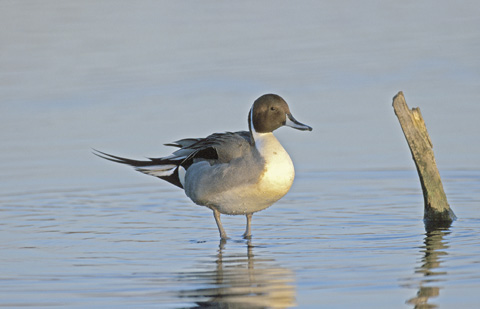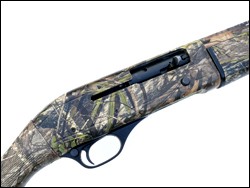
It’s an exciting time for duck shooters, with months of the new season stretching before us. After half a year of waiting, the keen hunger for action, which is half the joy of the sport, will soon be satisfied.
For many, thoughts will turn to stubble fields with mallard sailing in to feed, or to a pair sizzling in the roasting pan. To my mind a properly roasted mallard beats all the fowl and game on the table. Before considering cooking preferences though, we first have to procure the ingredient.
Mallard
Everyone who shoots will be familiar with this variety and a good percentage of ‘first ducks’ will have been a mallard. Mine was. I can still picture the scene clearly even though 56 years have passed.
To be pedantic, only the male is the mallard. The female was always known as the wild duck. Most coming to the bag in September will, at first glance, all look like females because drakes are still in the eclipse plumage. Once in the hand, sexing is easy. The bill of the male this early in the season is pale green, which turns yellow when the winter plumage grows. That of the duck is a brownish yellow with brown blotches.
Another sure way is to check the speculum. The blue feathers are bordered with white – the white line in the case of the drake ends at the edge of the blue, whereas that on the duck extends beyond the blue. That useful tip was passed on to me by Tony Cook when he was decoy man at Borough Fen. It had probably been handed down through the generations.
On the wing? Well, the harsh quack of the duck will identify her before she comes into view, whilst her mate is so quiet you might not hear him except over the feeding grounds. Then the waiting gunner is alerted by that wonderful stuttering kekkekekek! Whilst most duck are paired within their teams and companies, it is mallard you are most likely to see flying as a single pair. The duck usually leads.
Teal
Nationally, inland as well as on the coast, this is likely to be the next type of duck you will come across. Fast, infuriating, beautiful and delicious are all suitable adjectives. They are just as likely to be found on minute wooded ponds as on the saltmarsh. Washlands, tidal rivers and little brooks will all be frequented by teal. They love seeds, so freshly flooded grassland is a definite draw.
 Wildfowlers need to be perfectly poised to react to the green flash of the speedy and handsome teal.
Wildfowlers need to be perfectly poised to react to the green flash of the speedy and handsome teal.
Most wildfowlers will have experienced that most disconcerting manoeuvre when a spring of teal are approaching nicely, but as the gun swings up they corkscrew and burst out in all directions. It takes a cool head to remain focused on one bird. Pick a teal and stick with it? Yeah, right!
Although they often fly low, teal are by no means always easy to hit. I was once up on a tidal river bank when the tide was so low that I was shooting down at teal as they sped along just above the surface. It was a strange experience and there were several misses before I began to score.
At the other extreme, I have shot over a small pond no more than 20 yards in diameter where the duck always came from the east over tall trees. The few mallard came early and could be taken as they topped the trees, but the teal arrived at deep dusk to drop vertically down to the pond. I found them almost impossible, yet quite fascinating.
The time when teal seem to lose their wariness is when they are distracted by a swimming dog. Whether the dog’s head ploughing the surface appears to them as a duck on the move I’m not sure, but it seems to be something of that nature. More than once I have had a teal down in the river and as the dog has gone out to retrieve, more have turned up and swooped down as though to decoys.
Quite often a flushed teal will fly away only to turn and come back over you – higher yes, but often within range.
With a green-striped chestnut head and finely pencilled markings, the drake is a handsome fellow. His piping call and the high quack of his mate and, most of all, rocketing escape flight ensure teal hold fond memories for the wildfowler.
Wigeon
Of all the duck family the wigeon might be the wildfowler’s duck. The very mention of its name invokes the romance of moonlit saltings or splashes of floodwater on inland grazing marshes. The drake’s high-pitched wheeo will be familiar to all wildfowlers, as will the nasal snaaarrrr of the ducks, usually when accompanied by others of their kind.
My first experience of shooting under the magic of moonlight on Boxing Day night, 1959, coincided with a perfect sky. The spectacle of arc after arc of flickering black shapes passing over the face of the moon captivated an awestruck youth. No matter that they were high and out of range, from that day forth I was hooked. For me, for sheer excitement, nothing – geese included – can touch the enchantment of wigeon under the moon.
In the right circumstances, wigeon respond well to a call. A natural whistle is best, but in the cold, as it usually is when fowling, I for one cannot produce a loud enough note. I make my call from the brass heads of a brace of eight–bore cartridges. Primers and cardboard cases are burned out and one head pushed into the other and ‘dished’ with a ball peen hammer: 12s work but are shrill. The eight has just the right sound.
 “For sheer excitement, nothing – geese included – can touch the enchantment of wigeon under the moon.”
“For sheer excitement, nothing – geese included – can touch the enchantment of wigeon under the moon.”
Both sexes sport a snow-white belly and, of course, the drake has prominent white shoulders, although with immature birds neither the shoulder patches nor the beige band down the front of the head are so developed. Anyone who has left shot wigeon lying belly up might have noticed the next passing wigeon will decoy right in, possibly thinking the white is the shoulder of a fellow. That is obviously the thinking behind the use of oversized decoys. Using elastic bands, I have fixed the wings of drake wigeon to my mallard decoys, making them much more visible in the dark.
Most duck will fly with their mate whilst in large companies, but I’ve only ever known wigeon to follow down their stricken comrade. The first time I witnessed this I was walking beside frozen floods when a bunch of wigeon swept out of the fog. My quick shot folded one up, but two fell – the second, nose-diving as though hard hit. As the dead bird thudded onto the ice, the other somehow pulled out of his dive and flew away. Even then, I still thought the bird was hit and had recovered. It wasn’t until it happened again that I realised the truth.
Another wigeon discovery was made by way of curiosity borne of frustration. Time and again I had seen packs of wigeon feeding along the edge of the mud of our tidal river where they were out of bounds. However, I had confidently expected them to flight out over the Washlands at deep dusk. Knowing the habits of the species, I hung on long after dark, but to no avail. Not even a whistle heralded their departure. It was not until after the season had ended one year that I got permission to observe the forbidden area. At dusk the whole lot drifted off on the ebb tide in a raft, no doubt to take flight a couple of miles downstream.
Pintail
This has to be our most graceful duck. They are masters of the air and long of neck and wing, with a four-inch black tail on the drake. The immature drakes can be identified by their shorter tails and sometimes slighter build, but their prripp prrip call is the same. They are fine-looking birds and always treasured in the bag. I have found them less wary than other duck and probably easier to decoy.
 With its good looks and graceful flight, the pintail is one of our most aesthetically pleasing ducks.
With its good looks and graceful flight, the pintail is one of our most aesthetically pleasing ducks.
I experimented once when I found a party of pintail on floodwater out of range of the bank, behind which I was hidden. I had a yellow dog at the time and sent him out to trot along the water’s edge. To my amazement the pintail spotted him and with aggressive chuntering swam towards this cheeky ‘fox’ to give him a piece of their minds. When they had moved in as near as possible I was able to bring one down with a long shot and a heavy charge. Pintail love flooded or rotten potatoes and, although they often consort with wigeon, they will leave them for the grass if ‘tatties are on offer.
The divers
Of the divers, tufted duck and pochard are perhaps the most common. Tufted duck haunt rivers and fresh marshes, but it is usually icy before the pochard leaves the lakes and gravel pits that it loves. I did find a nest on a rough marsh one spring. The eggs are larger than the mallard’s.
 The rusty headed, stocky pochard is a cherished addition to any bag.
The rusty headed, stocky pochard is a cherished addition to any bag.
 Tufted ducks generally fly in a straight line and can be relatively easy to shoot.
Tufted ducks generally fly in a straight line and can be relatively easy to shoot.
Both species tend to fly straight and can be relatively easy to shoot, but given height they provide a testing shot. The black and white tufted is often scorned as a table bird, but the broad breasted pochard with his red head is prized – yet they have similar diets. Is it all in the mind? Why not compare the taste yourself?
Phil Gray’s top five wildfowling spots in the UK
More Shooting Gazette features
This article first appeared in the September 2013 issue of Shooting Gazette



 The writer could hardly believe his eyes when, on one occasion, a skein of Brent geese, a bird seldom seen on his patch, passed within 100 yards his hide.
The writer could hardly believe his eyes when, on one occasion, a skein of Brent geese, a bird seldom seen on his patch, passed within 100 yards his hide.
 The beautiful greylag goose is one of the author’s favourite birds.
The beautiful greylag goose is one of the author’s favourite birds.








































 Lincoln Premier Wildfowling Gun
Lincoln Premier Wildfowling Gun
 ATA Venza
ATA Venza











